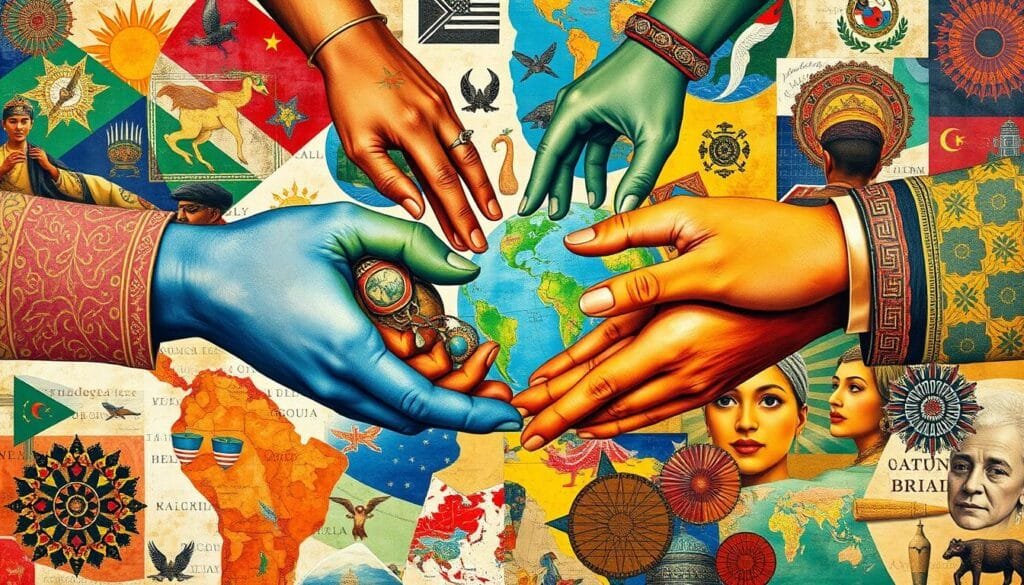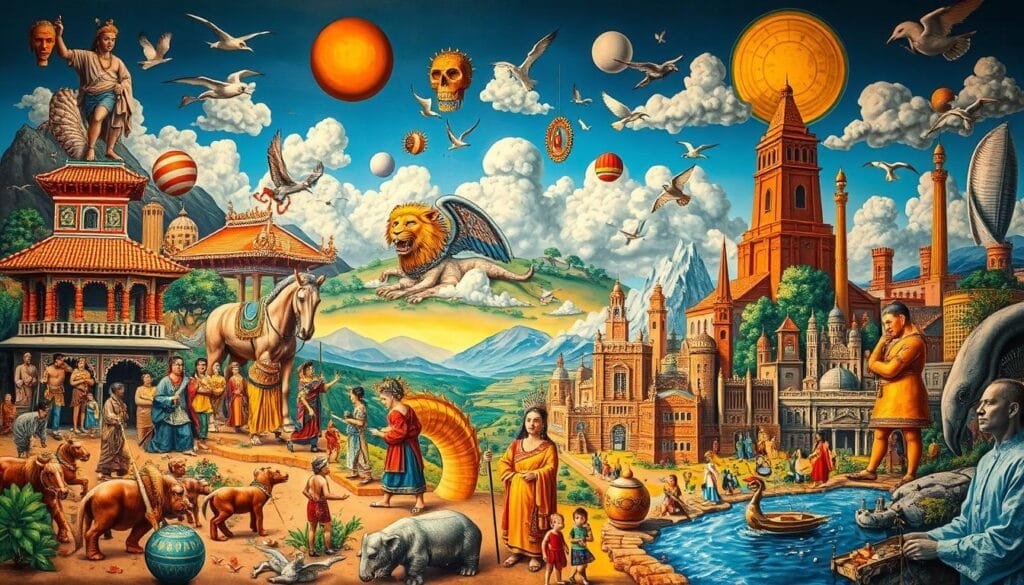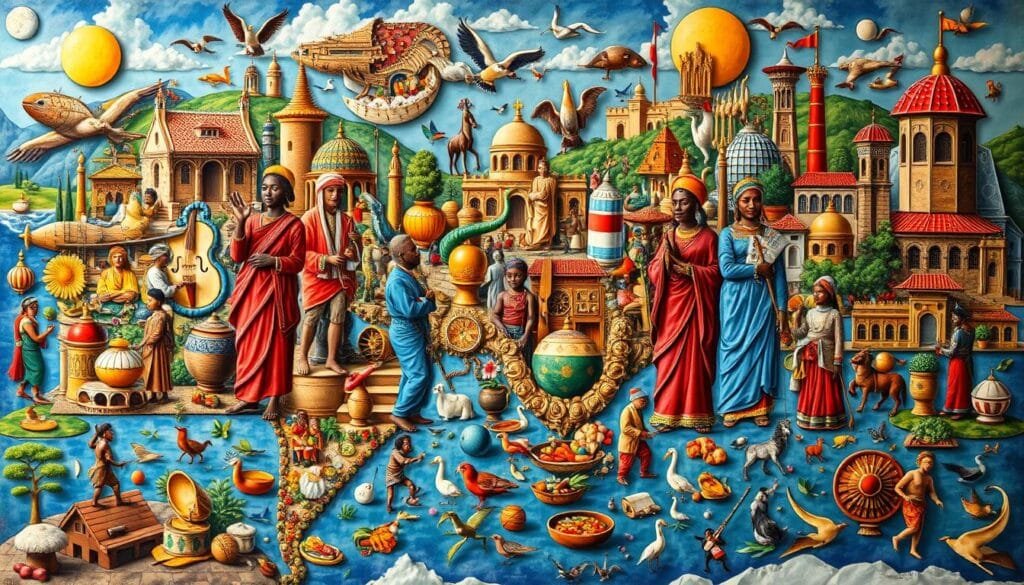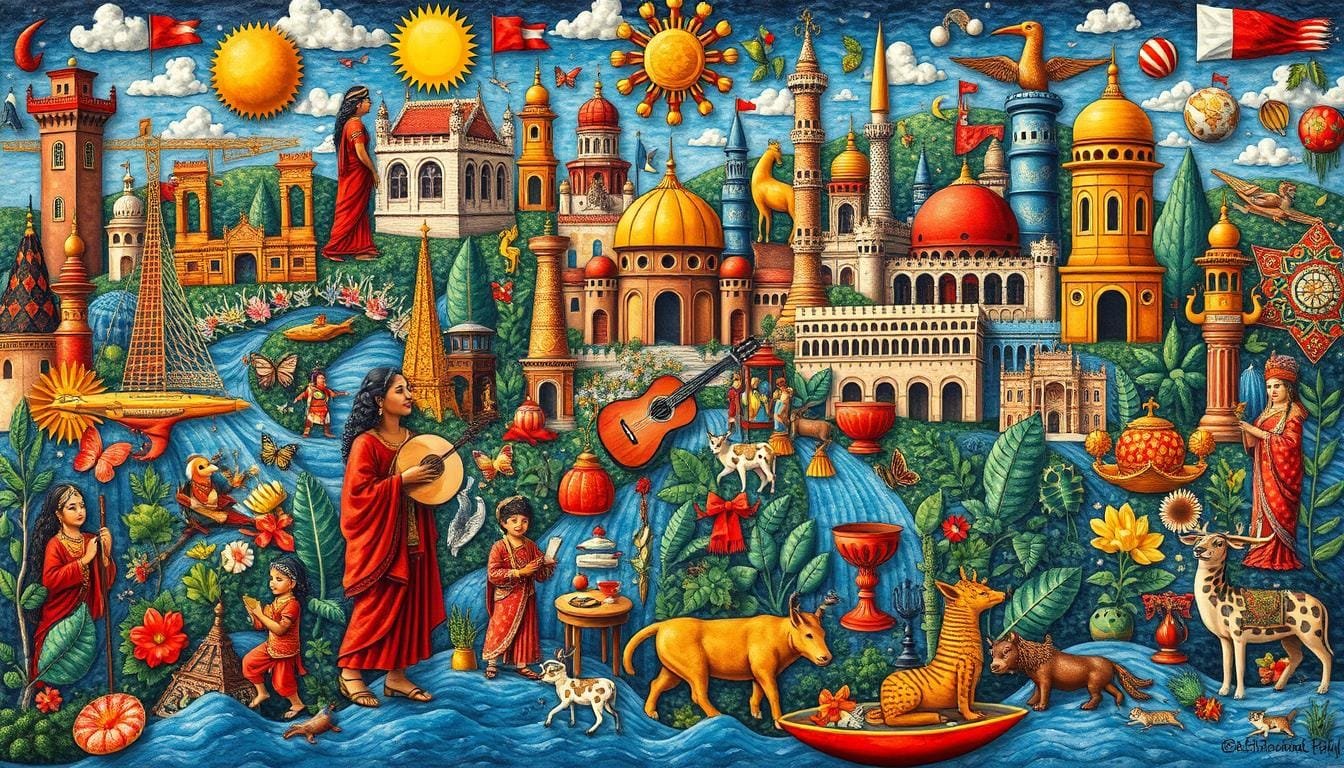Have you ever thought about how culture impacts our lives daily? It shapes who we are, often without us noticing. It includes behaviors, beliefs, values, and symbols passed down from generation to generation. But what really is culture, and why is it important to us?
Professor Hofstede sees culture as the programming of our minds that makes groups different. This programming helps form our collective experiences. He calls these “softwares of the mind,” crucial for how we view and interact with our world.
Culture has many layers, like an onion. It ranges from visible symbols like flags to deep values from our upbringing. Heroes and rituals are part of these layers. They show ideal behaviors and practices. For example, rituals are key in shaping our minds. This includes big events and everyday habits.
We learn that culture is complex and changes over time. So, what does culture mean to us on a larger scale? Let’s dive into this rich topic. We’ll see how our personal identities are shaped by culture, even if we don’t see it.
Key Takeaways
- Culture is the collective programming of the human mind, distinguishing one group from another.
- Understanding culture means looking at its layered structure, from symbols to core values.
- Rituals and heroes are key in forming cultural norms and behaviors.
- Studying culture shows us how our personal identities are shaped by groups.
- Cultural values and practices change and grow over time.
Defining Culture: An Overview
To understand culture, we must dig deep into its elements. By looking at various cultural dimensions, we understand how culture affects us and our society. The main aspects of culture include its shared programming, how it passes from person to person, and the importance of symbols, heroes, and rituals.
Culture as a Collective Programming
Hofstede explained culture as the mind’s collective programming. This programming separates groups with unique practices and beliefs from shared experiences. Different indices, like the Power Distance Index and the Uncertainty Avoidance Index, show how cultures deal with inequality and uncertainty.
Social Transmission of Culture
Defining culture includes recognizing its ability to continue through transmission. This process keeps cultural norms and values alive across generations. Communication is key, with symbolic interactions keeping social bonds strong.
Symbols, Heroes, and Rituals
Symbols, heroes, and rituals are crucial in expressing culture. They range from simple signs to complex practices. Symbols carry meanings specific to their context, heroes model ideal behavior, and rituals bring people together through meaningful activities. These elements help us understand culture’s collective programming.
| Cultural Dimension | Description |
|---|---|
| Power Distance Index | Measures the degree of inequality in a society. |
| Uncertainty Avoidance Index | Assesses how a society feels about ambiguity. |
| Individualism Index | Evaluates the level of individualism versus collectivism. |
| Masculinity Index | Measures the emphasis on assertiveness and achievement. |
The Impact of Culture on Identity
Culture and identity are closely linked. Our personal identity and social roles are shaped by cultural values. This connection changes over time, adapting to new influences like media.
Formation of Individual Identity
Identity starts forming from birth. Our family, community, gender, and religion play big roles at first. Later, media and globalization add to our views and actions.
Culture deeply affects how we see ourselves and make decisions. It teaches us norms and guides our beliefs.
Identity within Social Groups
In groups, culture also matters a lot. It brings people together, creating a sense of belonging. Group norms stem from shared values, shaping our place in the group.
Our social identities get stronger as we match our actions with group expectations. Moving places and mixing cultures make our identities rich and complex. This helps us in a global society.
| Statistical Insights | Details |
|---|---|
| Variations in Cultural Meanings | 160 distinct interpretations identified by Kroeber & Kluckhohn (1952) |
| Diversity in Cultural Backgrounds | Survey of NSW teachers (2011) revealed 1,155 unique cultural descriptions |
| Complexity of Identity Influences | Factors include mass media, popular culture, globalization, migration, inter-marriage |
| Need for Belongingness | Fundamental human requirement influencing cultural identity |
| Triggers for Cultural Awareness | Encountering differing cultural norms |
| Frequency of Cultural Identity Reflection | Monthly reviews suggested for understanding identity evolution |
Culture and Communication
In our world today, cultural communication is very important in everyday talks. Through language and culture, we share who we are and connect with others deeply. Culture changes as people and their interactions evolve.

Edward Hall shed light on cultural complexity in our world. He showed that to outsiders, some cultural practices seem strange, leading to misunderstandings. He stressed that understanding cultural communication is key for mutual respect.
Communication in a culture does three big things. It connects people, gives a shared identity, and helps folks interact. These parts are vital for relationships within and across cultures. We make these connections through language, rituals, and decoding cultural symbols.
Knowing how to decipher cultural signs is key in cross-cultural talks. The language and culture in a community show its values and knowledge. This helps in communicating well and helps subcultures blend into the wider group.
Thanks to travel and tech, we share cultural messages faster than ever. But just seeing cultural differences doesn’t mean we understand them. Studies say that really getting cultures requires effort to respect and decode their symbols.
Cultural traits can be obvious like language, or hidden in deeper meanings. Appreciating these can lower communication blocks and create welcoming spaces. It’s through these shared meanings that cultures maintain their values, shaping both individuals and groups.
Historical Perspectives on Culture
Exploring history of culture lets us see how every cultural tradition or value started. It shows us the growth of societies over ages. This understanding deepens our appreciation for cultural variety and shows how cultures change over time. How we view our history closely affects the traits and values in our societies today.

Culture and Historical Context
Looking at specific studies reveals the lasting impact of past events on cultural traits. For instance, Nunn’s 2009 work connects historical events to today’s cultural patterns. Also, exploring different European legal systems shows how cultural traits can influence economic growth. Boyd and Richerson in 2005 found that cultural evolution slows down in unchanging environments with high learning costs.
Important studies, like Bechara et al.’s in 1997, show how our brains learn without us knowing under extreme pressure. This reveals the slow, complex change of cultural norms and behaviors through cognition and culture.
Traditions and Modernization
Traditions are the bedrock of our beliefs and actions, offering steadiness. Yet, modernization shifts these traditions, mirroring overall cultural changes. Historic events often cause lasting cultural modifications, showing a society’s resilience and adaptability. Recent studies spotlight this shift, focusing on the area of historical culture.
| Historical Influence | Modern Adaptation |
|---|---|
| Nunn (2009) – Long-term impact of historical events on culture | Boyd and Richerson (2005) – Stability slows cultural evolution |
| Transplantation of European institutions | High-stakes learning and decision-making (Bechara et al. 1997) |
| Historical memory and representation | Interdisciplinary studies and Master’s programs (University of Barcelona, 2011) |
Exploring how traditions change with modernity helps us understand cultural evolution. We see how societies respond to new challenges and technology. The study of historical culture grows, linking past events to today’s customs and practices.
What Does Culture Mean?
Exploring the definition of culture opens our eyes to human behaviors, values, and symbols that make each society unique. A.L. Kroeber and Clyde Kluckhohn, U.S. anthropologists, found 164 ways to define culture in their 1952 study. They describe culture as a collection of knowledge, beliefs, art, and customs learned by people in society.

Acknowledging cultural diversity means understanding these components. Edward Burnett Tylor, in 1871, defined culture broadly. He included knowledge, beliefs, art, and customs as parts of culture learned by humans in society.
Today, we see culture as an abstract concept, formed by human actions and interactions. Kroeber and Kluckhohn explained that culture influences and is influenced by human behavior. This shows why it’s important to appreciate the diverse cultures around us.
Animals also have behavioral traditions, which means some cultural traits go beyond humans. The difference is in humans’ unique ability to use symbols. This ability is thought to come from our brain but is not fully understood.
Humans have evolved in how we express culture, from simple actions to complex symbols. This evolution has helped us survive and advance. Cultural behaviors became especially complex around 50,000 years ago.
Culture influences many areas, like music and heritage. The Beatles changed music culture over fifty years ago. Organizations like UNESCO protect cultural sites, showing how much we value cultural traditions and diversity.
Studies show culture deeply affects social connections. According to sociologists, 76% believe culture is key to society. Shared cultural events like weddings boost social ties by up to 40%, proving culture’s powerful role in bringing people together.
Material vs. Non-Material Culture
Culture includes both material culture and non-material culture. These aspects shape societies around the world. Understanding them helps us grasp cultural identity.
Examples of Material Culture
Material culture consists of physical items important to society. Examples of cultural objects are:
- Art: This includes paintings, sculptures, and crafts that show creativity and heritage.
- Architecture: Buildings and structures such as Egypt’s Pyramids and tall skyscrapers.
- Technology: Items like smartphones and computers drive tech progress.
- Clothing: This could be traditional outfits like Scottish kilts or modern trends.
- Food: Foods like Indian curry highlight local flavors and traditions.
Examples of Non-Material Culture
Non-material culture is about unseen aspects that shape our lifestyle. This includes:
- Values: Principles such as respecting elders, common in Asian cultures.
- Norms: Social behaviors like lining up, based on unwritten rules.
- Language: Communication methods like English that help share culture.
- Beliefs: Faiths such as Christianity that influence our morals.
- Symbols: Objects like the American flag represent national identity.
Both material and non-material culture play key roles. Physical objects show our values, and norms and beliefs direct how they’re used. Experts in fields like archaeology and sociology provide deep insights into this relationship.
| Material Culture | Non-Material Culture |
|---|---|
| Physical Objects | Ideas and Beliefs |
| Architecture | Norms |
| Art | Values |
| Technology | Language |
| Clothing | Symbols |
| Food | Religion |
Cultural Relativism vs. Ethnocentrism
Cultural relativism and ethnocentrism help us understand cultural differences. Cultural relativism means looking at a culture through its own norms. Ethnocentrism, however, means judging another culture by one’s own standards. This knowledge is key to respect and good communication across cultures.
| Concept | Key Statistics |
|---|---|
| Cultural Relativism |
|
| Ethnocentrism |
|
One example of ethnocentrism is how some Americans view driving on the left in England. They see it as the “wrong” way, a sign of cultural superiority. This attitude can lead to conflicts and tension in society. In the 20th century, extreme ethnocentrism caused over 40 big conflicts.
In contrast, cultural relativism benefits cross-cultural connections. Talking with people from other cultures can boost understanding and appreciation by 60%. Despite its difficulties, over 65% in a survey felt cultural relativism is essential for cultural diversity.
More research shows that knowing cultural differences leads to better communication. For example, people in the Middle East stand close when they talk, unlike North Americans. This shows big differences in how people interact.
Conclusion
As we wrap up, we see how culture deeply connects our actions, beliefs, and interactions. It’s more than just a simple idea. Culture is lively, growing alongside humanity, shaping our personal and social lives.
Looking back, cultures have grown since farming began about 10,000 years ago. When cities formed around 3,000 B.C.E, it marked a big leap in cultural growth. The creation of “symbolic culture” shows that understanding culture has always mattered to societies.
Different kinds of thinking, like Durkheimian and Weberian, show that cultural insights span across time and place. Great minds and religious leaders have aimed to create universal values. This teaches us that wisdom and cultural expressions have varied greatly through time. Modern times bring a new kind of logic, unique but just as important as in the past.
Grasping culture is key to connecting globally and valuing our differences. From our social setups linked with nature to diverse ways of thinking, cultural knowledge helps us manage our complex world. In the end, culture is a core part of how societies organize and how we see ourselves. It’s crucial to cherish our varied cultural backgrounds.
FAQ
What is the cultural definition?
Culture involves the beliefs, behaviors, values, and symbols handed down through generations. We often absorb it without thinking, through communication. It marks the identity of a group, differentiating one from another.
How is culture transmitted socially?
Culture travels from one generation to the next mostly through communication. Symbols and interactions play a big part. This is how social norms form, sharing the group’s values and beliefs.
What roles do symbols, heroes, and rituals play in culture?
Symbols hold specific meanings in a culture. Heroes embody what a society values most. Rituals bring people together, living out shared beliefs. All these aspects mirror what a society treasures.
How does culture impact personal identity?
Our cultural background molds our personal norms and how we behave. It’s key to developing who we are. This shapes how we view ourselves and our interactions within our communities.
What role does culture play in forming social identity?
Culture creates a sense of belonging through shared practices and values. It forges a strong link between personal and group identity. This is based on common cultural grounds.
How is communication important in culture?
Communication breathes life into culture by expressing and passing on values. Through language and symbols, a community’s essence and wisdom are shared. This builds understanding and connections among different cultures.
How is culture related to historical context?
Cultural elements trace back to the histories of their people, showing their journey through time. Traditions reflect deep-seated practices and beliefs. Meanwhile, the evolution of culture highlights adaptability to new challenges and influences.
What is the difference between material and non-material culture?
Material culture is tangible, like art or buildings, defining culture through objects. Non-material culture deals with the intangible, such as beliefs and values, guiding how people live and interact.
Can you provide examples of material culture?
Material culture includes things like artwork, buildings, weapons, and household items. They are a window into a society’s customs and play a part in shaping cultural identity.
What are some examples of non-material culture?
Non-material culture covers concepts that influence lifestyle, like spirituality, ethics, and communication. Elements such as religious beliefs, moral values, and language fall under this category.
What is cultural relativism?
Cultural relativism means understanding a culture by its own norms instead of comparing it to ours. It promotes tolerance and appreciates the diversity among cultures.
What is ethnocentrism?
Ethnocentrism is when we judge other cultures by our standards, leading to misunderstandings. It overlooks the richness of different cultural practices and can cause conflict.
